Tillandsia riohondoensis
new classification of many T. capitata 'Rio Hondo', some T. capitata 'Peach' & other 'Nursery Names'
see T. capitata pages for more pictures.
Tillandsia riohondoensis
Chris Larson 05/08/15 ... "The German journal arrived in the post today & finally T. riohondoensis has been published – there is one article by Renate Ehlers and another by Derek Butcher.
So now the tags may be changed on all of those T. capitata Rio Hondo & some of those T. capitata Peach. Be careful with the T. capitata Peach – as the real T. capitata Peach (from Mexico) is not T. riohondoensis – just all of those ones that come through the Guatemalan trade that Collectors Corner & Ari sold in large numbers for quite a few years, so there will be a lot of them around."
Geoff Lawn 05/08/15 ... "Chris: Are the T. 'capitata Peach' forms from Guatemala through Collectors Corner and Ari in Australia the same as those sold in Florida ? Derek Butcher & Dennis Cathcart (Tropiflora nursery, Florida) decided nearly 2 years ago that the Florida imports ex Guatemala should have their own cultivar name to separate them from the Mexican 'Capitata Peach' so they became registered as T. 'Guatemalan Peach' - see http://botu07.bio.uu.nl/bcg/bcr/index.php
I just want to know if this T. 'Guatemalan Peach' is now in fact T. riohondoensis ? If so, the BCR entry should reflect that, together with a copy of the Die Bromelie article."
Chris Larson 05/08/15 ... "Hi Geoff. To my mind there is one error in the otherwise great articles.
1. The plant that Derek registered as T. ”Guatemalan Peach” is a small clone of the Guatemalan plant and is not as caulescent. Derek says that it appears to be related to T. riohondoensis. I have not grown this particular plant so it is difficult to be sure – but I think that I know it from amongst the batches of what we receive as T. capitata Peach we receive from Guatemala.
2. In her article Renate says that T. riohondoensis sales “occurs under (T. sphaerocephala) ….but never, strangely, as T. capitata.” This is wrong. Before the mid 90’s it was referred to as T. sphaerocephala, but since the mid 90’s it has practically always is referred to as T. capitata Peach in the Guatemalan trade.
3. All T. riohondoensis sold by Collectors Corner prior to around 2000 to 2005 were sold as T. capitata Peach. Ari sold T. riohondoensis under both the names: T. capitata Peach or T. sphaerocephala.
4. All T. riohondoensis sold by Collectors Corner after around 2005 were sold as T. capitata Rio Hondo - which were sold to us as T.capitata Peach so we re-label.
5. I believe that amongst the T. capitata Rio Hondo sourced directly from Guatemala, that CC have sold over the past 10 to 15 years, there have been some of this T. Guatemalan Peach amongst them. Though I cannot be sure.
6. Many nurseries around the world are still selling T. riohondoensis plant under the name T. capitata ‘Peach’.
From what Derek seems to imply in his article – T. Guatemalan Peach seems to be related to T. riohondoensis, but he doesn’t go further. I do not know if it fits within the description of T. riohondoensis.
One thing for sure – most of us have just added a new species to our collection today !!"
Derek Butcher 06/08/15 ... "Chris: We know that Guatemalan Nurseries will continue to sell T. capitata Peach but it is still what I treat as a nursery man's name or NN. The pertinent paragraphs in my article seem to me to be as quoted.
"If you are a grower who prides himself/herself on having a keen interest on plant identity you will be pleased to know that we have decided to coin two new names for the Register – Tillandsia ‘ Capitata Peach’ and Tillandsia ‘Guatemalan Peach’. "
We leave it to you to decide, which name best fits your plant and suggest to others, who sell these plants, to use the new names, including ‘Rio Hondo’ if applicable.'
"In this issue, Renate Ehlers finally publishes Tillandsia riohondoensis because in the many years since the first introduction nothing moved forward in identifying and classification of all these many plants called T. capitata. So she decided to go the first step and publish this outstanding plant. So from now on you can label your plants as T. riohondoensis."
As far as Renate's comment goes, we do not know what happened in Germany.
As far as 'Guatemalan Peach' goes Dennis assured me that he knew what 'Rio Hondo' looked like and that what he was selling as capitata 'Peach' which came from Guatemala was different. How many different plants are sold as capitata 'Peach' by Guatemalan nurseries is anyone's guess."
Chris Larson 06/08/15 ... "Hi Derek. The vast majority (probably much more than 95%) of the 1000’s of T. capitata Peach from Guatemala (from multiple sources) I’ve seen seem to fit T. riohondoensis – and the same with the photos of “air plant” vendors sites I have seen on the net. I would say that most people who have a supposed T. capitata Peach in their collections, around the world, would have T. riohondoensis & not the registered Mexican plant – and that any “T. capitata ‘Peach’” or “T. sphaerocephala” that they do have should be compared with the BCR photos of the registered T. ”Capitata Peach”, T. ”Guatemalan Peach” & the published photos of T. riohondoensis (& sphaerocephala). We fanatics will look into identity, but others who still do care about having the right names on their plants will not go to the same lengths, & I feel an omission of this or a similar statement will mean the articles will be less relevant to most that want to sort out if they have T. riohondoensis in their collections.
And off that topic and moving on.
If Dennis’ T. Guatemalan Peach is the same as what I think I’ve seen – it appears to be in the variety of plants we receive as T. capitata Peach, & be just a distinct form of these plants. From the description & phot on the BCR it appears to be of a small form of T. riohondoensis – but the BCR doesn’t say how small. Has anyone compared it with the provisional description of T. riohondoensis? That will be the answer to Geoff’s question. I will try to separate a smaller much less caulescent plant we receive in the shipments from Guate for comparison. (Many will know that the provisional T. riohondoensis description is available on the disc in the NYP section.) The whopping big form (thick leaved and very stocky, but definitely caulescent), posted here in the past, is certainly notable and probably also worthy of cv status – Pedro says that he got it in the 80’s & Collectors Corner also got it occasionally in the batches much later. Much more than 95% of the plants we receive as T. capitata Peach are pretty much the same as Renate’s photos of T. riohondoensis, but there are a couple of notable forms.
Another interesting comment by Renate in the article: "T. riohondoensis has been extinct in the wild since before 1994." While it must be said that stripping (other) species from the wild would still go on in Guatemala – the sheer numbers of T. riohondoensis still being produced by the nurseries in Guatemala is astounding & this is without replacement from new wild stock as there supposedly has been none for more than 20 years."
Derek Butcher 07/08/15 ... "Chris: From what I can gather Dennis wanted to separate the large 'Rio Hondo' from the smaller 'Guatemalan Peach'. With my species hat on I consider both to be T. riohondoensis.
As far as plants still being in the wild I would not treat as gospel Feldhoff's comment it was extinct. Competition between Guatemalan nurseries is such that you must be a good poker player to succeed."
Peter Tristram 07/08/15 ... "I am pleased this plant has been described as it is such a different looker to the typical ‘capitatas’. T. rhodocephala is another that got the nod. More will come. Harry referred to it as aff. capitata from Rio Hondo, Guatemala and I suppose it was Derek who shortened it to just Rio Hondo, the cultivar. It doesn’t seem to be extinct if the photos Jeronimo has posted from that area are an indication. Attached is a photo of what could be this species taken from his facebook page. There was a lengthy discussion about it a few years ago. As for Guatemalan capitata Peach, they look like Rio Hondo to me too, just another cultivar/form of what is a variable species. I have plants from Germany too but without data, that are also obviously riohondoensis and all have that typical inflorescence and rough scaling."
Derek Butcher 24/08/15 ... "Ian: I enclose information which should go into BinA under T. riohondoensis. You could also put "See T. riohondoensis" under the detail you have under T. 'Rio Hondo'.
My own view is that both 'Rio Hondo' and 'Guatemalan Peach' are within the variations you would expect under T. riohondoensis. No doubt we will see these three names plus T. capitata Peach (not to be confused with T. 'Capitata Peach' which come from Mexico) in the trade but I leave it up to the grower. Remember that not all growers are interested in names and only those interested will take heed of the advice given.
Life was not meant to be easy!"
Tillandsia riohondoensis

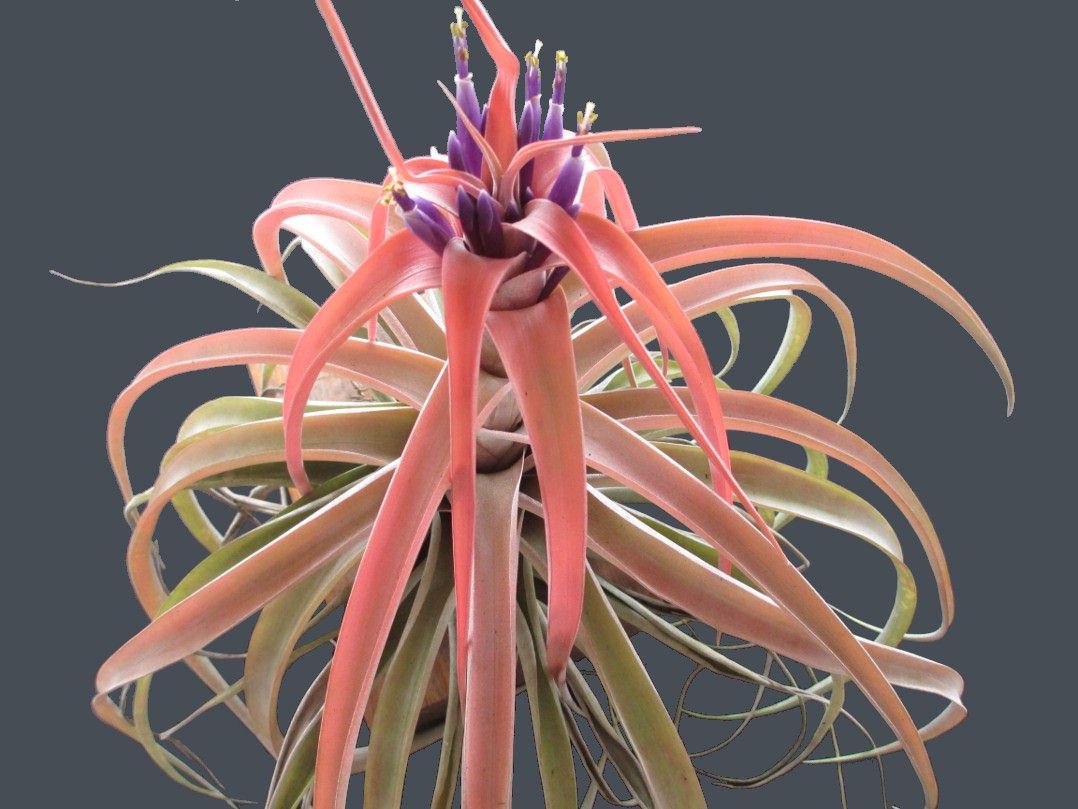

| Facebook - Jeronimo |
Bob Hudson 08/15 |
John Olsen 12/20 |
John Olsen ... "You would be entitled to think a clump this big could do better than 2 inflorescences. It had 3 when smaller years ago."


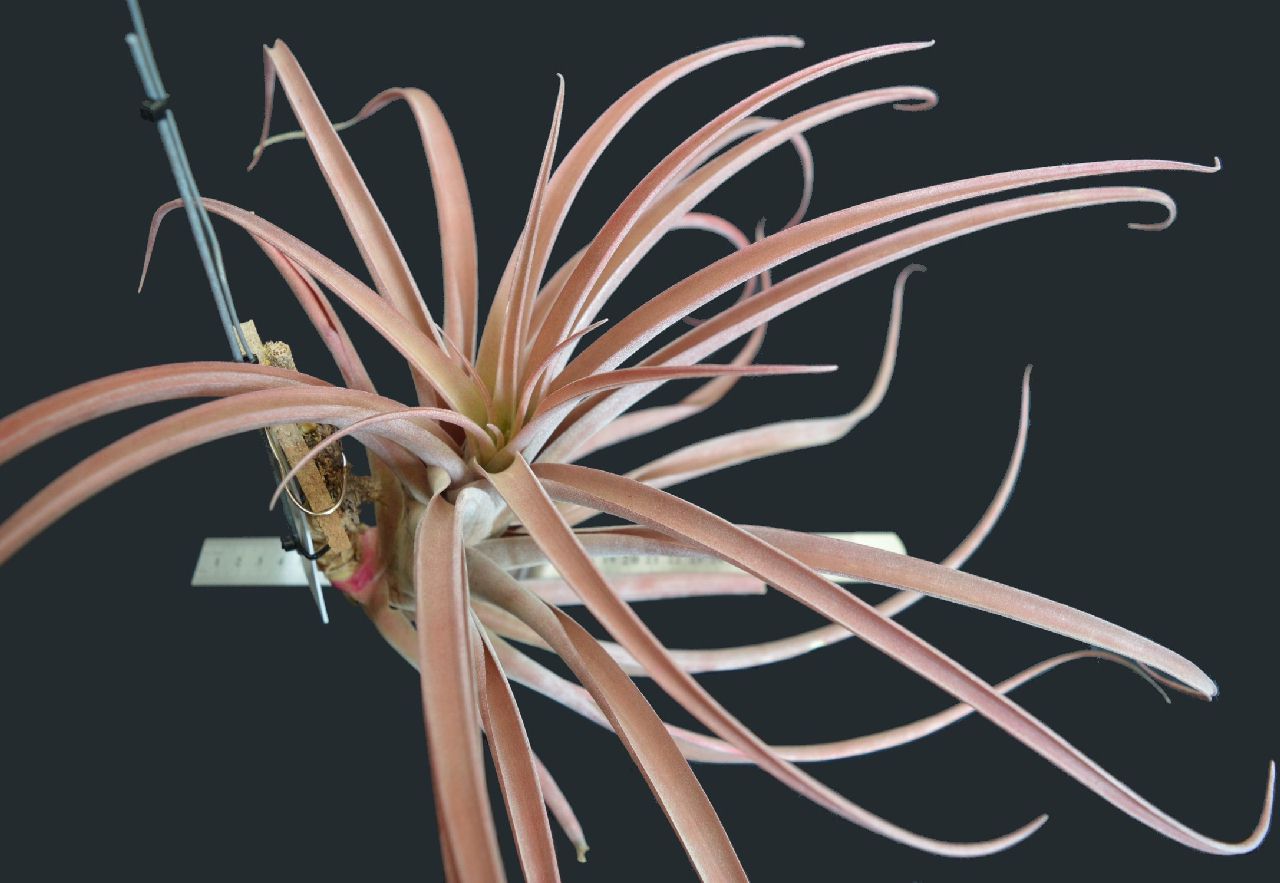
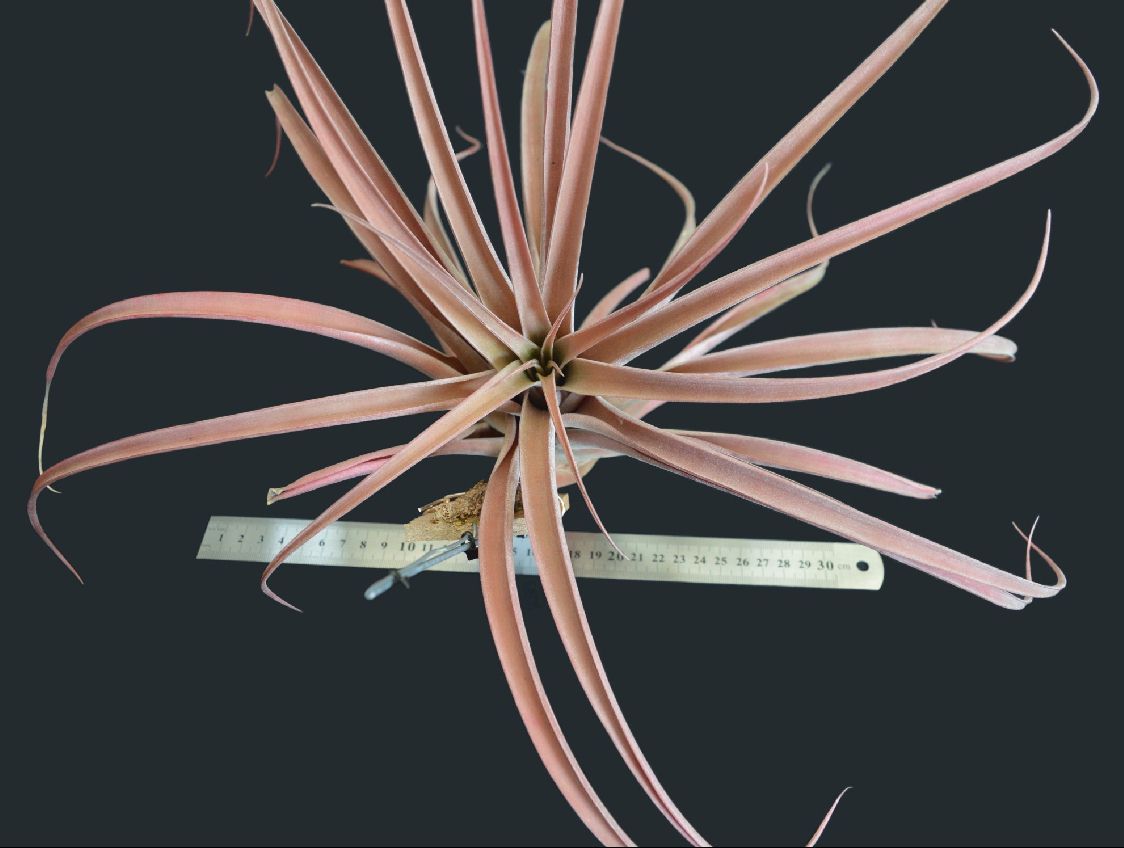
| Julie Batty 02/17 "very velvety leaves" |
Gary May 03/17 |
Gary May ... "here are a couple of shots of my riohondoensis which is nowhere near flowering.
My capitata peach doesn't have pink leaves until flowering and the leaves are much shorter. The riohondoensis is a showy plant from the moment the leaves are about 8cm long."
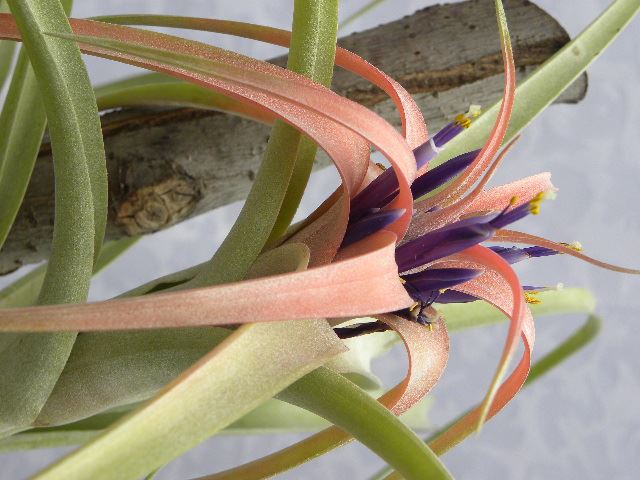

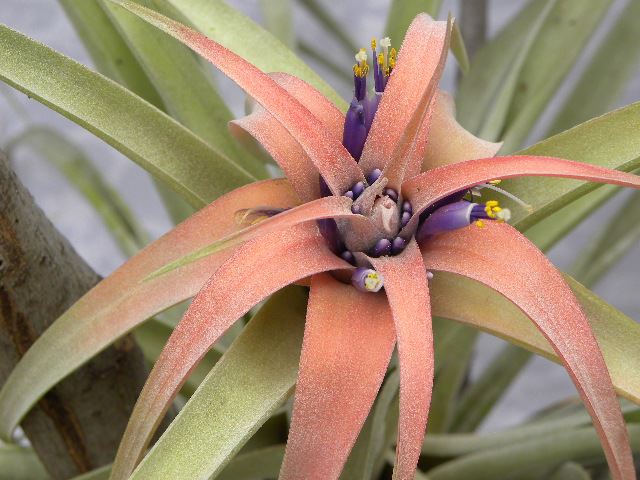
| Stan Olejnik 02/21 riohondoensis "large form" |



| in situ, Jeronimo |
Bruce Dunstan 01/23 grown in full sun |
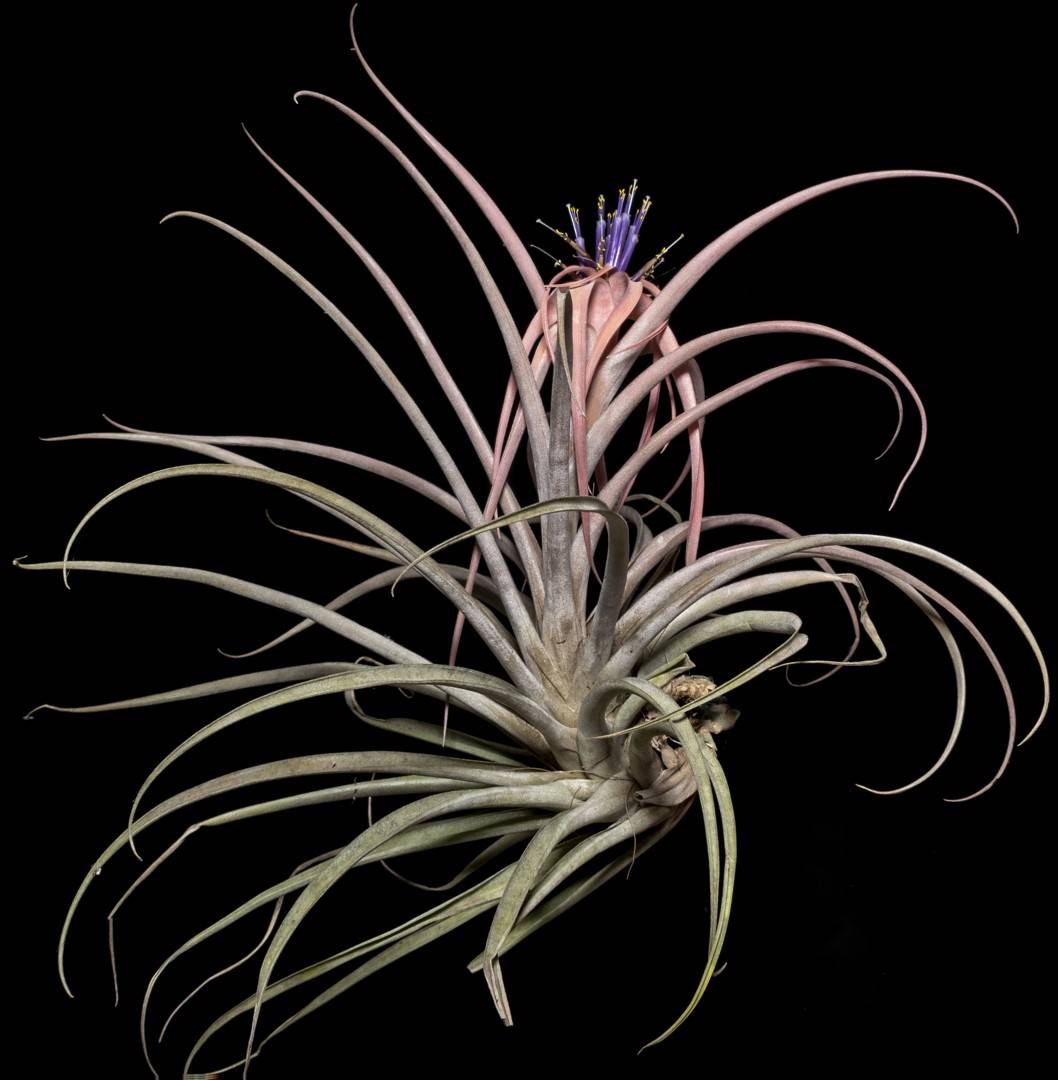



| Rob Bower 01/23 "Pink" |
Rob Bower 01/23 "Red" |
Tillandsia capitata and its identity problems by Derek Butcher in Die Brom 2015(2): 62-64. 2015
Tillandsia capitata came into being in 1866 with a plant found in Cuba. In the intervening 147 years many plants have been found throughout the Caribbean and mainland Central America and been given this species name, but come in all shapes and sizes. Ten years ago it seemed that a Cuban botanist was going to come to the rescue and give some meaning to the prevailing chaos, but alas nothing has eventuated even from DNA studies which seem to take front stage in botanists’ current deliberations. Let us now look at cultivars linked to T. capitata. We should remember that nature abhors a vacuum and so too do nurserymen. Therefore plants get given 'common' names and sometimes these are registered so all growers of bromeliads are aware. While it costs nothing in monetary terms to register it does take precious time to take the trouble.
This is a story about only part of the T. capitata identity crisis which some growers will heed and some not, but at least we try.
Let us go back to the Journal of the Bromeliad Society 56: 64 (2006) where I tried to solve certain naming problems for a plant found in Guatemala which looked like a Tillandsia capitata but was sufficiently different to warrant a new name. To summarise, in the early 1990's we had a plant variously called, T. xerographica x capitata, T. 'Maya' , T. sphaerocephala Guatemala, T. harrisii, T. capitata 'Yellow Rose' (in New Zealand), and a name that I coined: T. 'Rio Hondo'. The latter name was based on the name T. riohondoensis, a name that was used by Renate Ehlers, Germany in preparation of a publication of that new species. But at that time she decided not to publish this species because of the identity problems of T. capitata in the broad sense. The name 'Rio Hondo' however was duly registered but I would suggest there are still many of these plants around with these other names on the labels.
Now to phase 2: there is a plant circulating as Tillandsia capitata 'Peach', also from the early 1990's, which originated from Bird Rock Tropicals in California / USA under their inventory number 'T030'. It was originally collected in Mexico, but was never registered under that name.
Meanwhile there was a plant collected in Guatemala, which was also called Tillandsia capitata 'Peach'. We do not know who gave it that name, but we do know, it is being sold in Florida under this name. This plant has leaves that have that furry covering like a Peach, which is also shared by T. capitata 'Rio Hondo', but the plant is significantly smaller. Because we do not know the source of either plant we can only surmise they are closely related.
If you are a grower who prides himself/ herself on having a keen interest on plant identity you will be pleased to know that we have decided to coin two new names for the Register – Tillandsia 'Capitata Peach' and Tillandsia 'Guatemalan Peach'.
We leave it to you to decide which name best fits your plant and suggest to others, who sell these plants, to use the new names, including 'Rio Hondo' if applicable.
In this issue, Renate Ehlers finally publishes Tillandsia riohondoensis because in the many years since the first introduction nothing moved forward in identifying and classification of all these many plants called T. capitata. So she decided to go the first step and publish this outstanding plant. So from now on you can label your plants as T. riohondoensis.
Tillandsia riohondoensis Ehlers, sp. nov. Die Bromelie 2015 (2): 57-61. 2015
A Tillandsia capitata Griseb. caulibus longis, rosula secunda, prolibus numerosis in toto caule, foliis subchartaceis, percano lepidotis, pedunculo brevi, spicis dense aggregatis rhachis internodiis perbrevibus, spicis bifloris bracteis sterilibus basalibus absentibus, bracteis spicarum ambis faciebus dense lepidotis cum laminis perlongis, bracteis floriferis parvis sepalibus usque ad 3 mm brevioribus, valde carinatis, membranaceis et sepalis subliberis totis carinatis differt. –
Typus: Guatemala, Departamento Zacapa, in valle Rio Hondo, 200-500 m s. m., saxicola in rupibus subperpendicularibus prope cataractam, 1989, U. Feldhoff s.n. (holo WU).
Plant stem forming, flowering 20-80 cm high, rosette somewhat secund, 10-70 cm high, 15-40 cm in diameter.
Leaves up to 35 cm long, very thin leathery light green, both sides strongly lepidote and therefore appearing greenish grey, upright to somewhat recurved.
Sheaths 5-10 cm long, 3-4 cm wide, elliptic, slightly curved, the edges involute (bent inwards), the basal half light brown, densely fine lepidote.
Blades faintly distinct from the sheaths, 1.5-2.5 cm wide above the sheath, up to 25 cm long, triangular, rather flat, edges involute, tapering to a linear tip, apex recurved.
Peduncle fairly short, 3-6 cm long, 6-8 mm in diameter, curved upwards, densely covered by a few imbricate bracts, bracts foliate, red coloured at anthesis.
Inflorescence (fertile part) 4-8 cm long, 2-3 cm in diameter (without the primary bracts), capitate, panicle with side-branches of first order, 5-15 spikes, upright, very densely and polystichously arranged.
Primary bracts similar to peduncle bracts, up to 25 cm long, blades recurved, the upper ones with reduced blade, at anthesis bright carmine red, on both sides densely covered by coarse white trichomes, the sheaths completely enfolding and hiding the spikes.
Spikes sessile, 1.5-2 cm (up to 2.5 cm) long, 8-10 mm wide, narrowly elliptic, acuminate, complanate, usually with 2 flowers, at apex sometimes another stunted flower, but no flowerless bracts at the base.
Floral bracts 1.1-1.8 cm long, 6-10 mm wide, elliptical or delta shaped, weakly acute, 2-3 mm shorter than the sepals, strongly carinate, nerved, thin, membranous, pale green, glabrous.
Sepals 1.4-2.1 cm long, 6-8 mm wide, elliptical, acute, thin, membranous with hyaline edges, nerved, glabrous, all 3 (including the abaxial) keeled, sub-free, the adaxial pair fused 1 mm high.
Petals 5.5-6.5 cm long, 9-10 mm wide, dark purple, tapering to 4 mm at the base and becoming white, forming an upright tube, the rounded tips somewhat recurved.
Stamens protruding up to 1.5 cm from the flower.
Filaments 6.4-7 cm long, arranged in two whorls of unequal length, in the upper part oval in cross-section, 0.8 mm in diameter, violet, tapering to ribbon-like at the base and becoming white.
Anther 2.5-3 mm long, 0.8 mm wide,
attachment versatile 1/3 from the base, light brown or brown, pollen yolk-yellow.
Style 5.5-6.8 cm long, white, purple in the upper part.
Stigma 2 mm high, 1.2-2 mm wide, thin, white, with papillose spreading lobes (Type I according to Brown & Gilmartin).
Ovary 6-7 mm high, 2-2.2 mm wide at the base, elliptic, light green.
Distribution and habitat:
Tillandsia riohondoensis comes from Guatemala, near the Rio Hondo in the province of Zacapa, and is known, so far, only from this locality. The plant grows on rocks in a very hot area on very steep volcanic tuff near a waterfall.
Similar species
This new species differs from Tillandsia capitata Griseb. in the following characteristics:
Plant forming long stems, rosette secund.
Offsets not only appearing at the base, but also along the stem from the leaf axils.
Leaves lepidote, quite thin and very grey.
Peduncle quite short.
Spikes very dense, internodes very short. Spikes with two flowers each, at base no flowerless bracts.
The primary bracts are densely lepidote on both sides,
the blades are very long.
Flower bracts up to 3 mm shorter than the sepals, very small, strongly keeled, glabrous, membranous.
All three sepals keeled and subfree.
Etymology
This new species is named after the area where it was found, Rio Hondo in Guatemala.
Intro:
This plant has been on the market for a number of years and particularly in many American collections. It was sold by Guatemalan dealers as “Tillandsia sphaerocephala Guatemala". In German gardens and collections it also occurs under this or other fantasy names, but never, strangely, as T. capitata.
There are some offered as very small plants which come from offsets and were often cultivated by using flowering hormones. These plants seem often stemless or short stemmed. At the type locality or when mother plants are old, the plants are long stem-forming and much larger in diameter. The offsets appear, like in Tillandsia harrisii, willingly from the leaf axils along the entire length of the plant.
You can buy the plant as a common commercial plant, but, in nature near the Rio Hondo, it is extinct. In 1994 I received my plants from Uwe Feldhoff. Unfortunately, I was never able to see them in their natural habitat. When we were in Guatemala in 2010, I wanted to go with Uwe Feldhoff to Rio Hondo, but he reported that there were no more plants anymore.
Pertinent Emails
Subject RE: Tillandsia 'Rio Hondo'. From: "Harry Luther". To: "derek butcher"
Dear Derek; That Selby # is a hybrid from Guat., El Rancho area that is the Rio Honda aff capitata thing supposedly crossed with T. xerographica, very large and caulescent with conspicuous long red lateral branches. HEL
From : derek butcher. June 06, 2006. To: Harry Luther. Subject Tillandsia 'Rio Hondo'
Harry: Dennis tells me you have a similar plant under SEL92-0266. Does this originate with the Guatemalan mob? Are there links to 'Rio Hondo'?
Tillandsia ‘Rio Hondo’ by Derek Butcher, Bromeliad Cultivar Registrar J Brom Soc 56: 64. 2006
The recent naming of a Tillandsia maya in Novon:209-11. 2003 had me worried because we already have Tillandsia ‘Maya’ in the Cultivar Register and to further confuse it is likely that T. maya will be treated as T. xmaya! Plants named under the ICBN rules always have precedence over those named under ICNCP rules irrespective of date.
This and other query from Ken Woods here in Australia prompted me to action.
Dennis Cathcart named ‘Maya’ in Cargo Report #7-3 for a supposed natural hybrid of xerographica x capitata occurring in Guatemala. Some followed this naming and others not, so we see its photo in ‘New Tillandsia Handbook’ by Shimizu & Takizawa, 1998 on page 113 as a formula. Just for interest sake, on the same page you will see a Dimmitt hybrid namely T. xerographica x brachycaulos. This was named ‘Betty’ by Paul Isley. We know that T. brachycaulos and T. capitata are very similar, in fact some collected plants seem to fall between the parameters of both species. It depends whether you are a lumper or a splitter! To my mind a hybrid with these as parents should show some sort of similarity but in this case they don’t. Here the man-made hybrid gives a hint of what the natural hybrid should look like. In this case it adds weight to my belief that the parentage xerographica x capitata was the wrong one to use!
Apparently this all started in 1989 when Uwe Feldhoff collected a plant at Zacapa, Rio Hondatal, Guatemala and sent a specimen to Renate Ehlers in Germany. Investigations showed that it was different to what is generally considered to be the range of the very variable T. capitata. Although T. rhodocephala, another variant within T. capitata in the broad sense, was published in 1994, no action has yet been taken with this particular taxon.
Guatemalan exporters meanwhile, had also been selling this plant around the world to the general nursery trade as Tillandsia sphaerocephala Guatemala. The true T. sphaerocephala from Bolivia was, at that time, not common in collections and which in any event had been confused with T. schreiteri in Smith & Downs, Flora Neotropica. Never had it been found in Guatemala and in any event the stamens are included so it was an odd identification. The plant was also distributed by the name of T. harrisii to which it does have some vague similarity when young and not in flower!
When I knew that Renate Ehlers was not immediately going to describe this taxon I decided to call it by the name of Tillandsia ‘Rio Hondo’ and it is recorded as such in the Bromeliad Cultivar Register with notes referring to ‘Uncle Derek says’.
In July 2001 Anwyl Bromeliads in New Zealand, imported a shipment from Tropimeyer (Guatemala) that included Tillandsia "sphaerocephala.". 40 or 50 plants flowered whilst in the quarantine house, and all were the same and were given the provisional name of 'Yellow Rose' because the coloration of the primary bracts was quite different from any other Tillandsia capitata photos in the records. So several hundred of these plants are being grown in NZ collections with the label Tillandsia capitata 'Yellow Rose'. This colour was unique and may have been the result of the obligatory gassing because subsequently, remaining plants flowered later in cultivation with that orange coloured primary bract typical of ‘Rio Hondo’. Indeed, offsets from what were called ‘Yellow Rose’ flowered similarly.
To summarise, we have a plant variously called, T. xerographica x capitata, T.‘Maya’, T. sphaerocephala Guatemala, T. harrisii, Tillandsia capitata ‘Yellow Rose’ in New Zealand, and T. ‘Rio Hondo’.
Because of the duplication problem with T. ‘Maya’ would you please change all labels to read T. ‘Rio Hondo’ or T. capitata ‘Rio Hondo’and I will note the Cultivar Register accordingly.
References
R Ehlers & P. Koide, 1994, J. Brom. Soc. 44:130
Hideo Shimizu and Hiroyuki Takizawa, 1998, New Tillandsia Handbook Japan Cactus Planning Co. Press
L.B. Smith and R.Downs, 1977, Flora Neotropica, Monograph 14, Tillandsioideae, Hafner Press
Updated 27/02/23
















